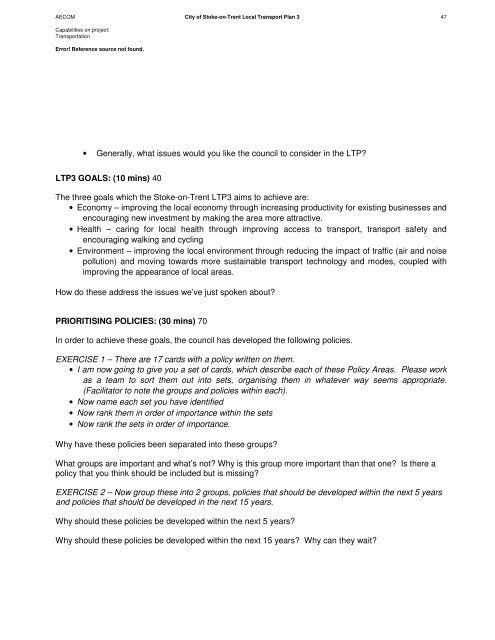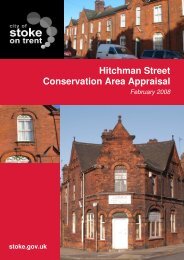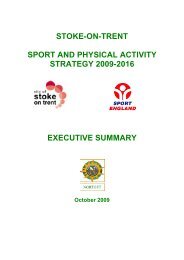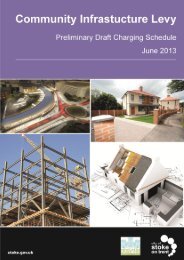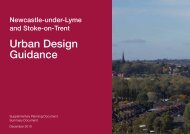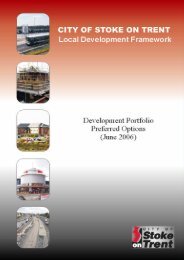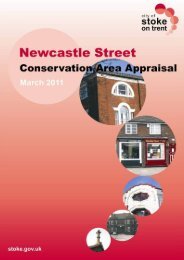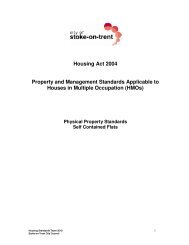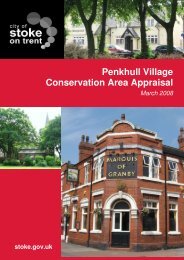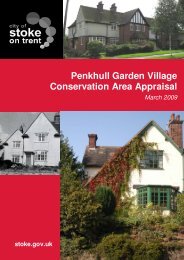AECOM <str<strong>on</strong>g>City</str<strong>on</strong>g> <str<strong>on</strong>g>of</str<strong>on</strong>g> <str<strong>on</strong>g>Stoke</str<strong>on</strong>g>-<strong>on</strong>-<strong>Trent</strong> <strong>Local</strong> <strong>Transport</strong> <strong>Plan</strong> 3 47Capabilities <strong>on</strong> project:<strong>Transport</strong>ati<strong>on</strong>Error! Reference source not found.• Generally, what issues would you like the council to c<strong>on</strong>sider in the LTP?LTP3 GOALS: (10 mins) 40The three goals which the <str<strong>on</strong>g>Stoke</str<strong>on</strong>g>-<strong>on</strong>-<strong>Trent</strong> LTP3 aims to achieve are:• Ec<strong>on</strong>omy – improving the local ec<strong>on</strong>omy through increasing productivity for existing businesses andencouraging new investment by making the area more attractive.• Health – caring for local health through improving access to transport, transport safety andencouraging walking and cycling• Envir<strong>on</strong>ment – improving the local envir<strong>on</strong>ment through reducing the impact <str<strong>on</strong>g>of</str<strong>on</strong>g> traffic (air and noisepolluti<strong>on</strong>) and moving towards more sustainable transport technology and modes, coupled withimproving the appearance <str<strong>on</strong>g>of</str<strong>on</strong>g> local areas.How do these address the issues we’ve just spoken about?PRIORITISING POLICIES: (30 mins) 70In order to achieve these goals, the council has developed the following policies.EXERCISE 1 – There are 17 cards with a policy written <strong>on</strong> them.• I am now going to give you a set <str<strong>on</strong>g>of</str<strong>on</strong>g> cards, which describe each <str<strong>on</strong>g>of</str<strong>on</strong>g> these Policy Areas. Please workas a team to sort them out into sets, organising them in whatever way seems appropriate.(Facilitator to note the groups and policies within each).• Now name each set you have identified• Now rank them in order <str<strong>on</strong>g>of</str<strong>on</strong>g> importance within the sets• Now rank the sets in order <str<strong>on</strong>g>of</str<strong>on</strong>g> importance.Why have these policies been separated into these groups?What groups are important and what’s not? Why is this group more important than that <strong>on</strong>e? Is there apolicy that you think should be included but is missing?EXERCISE 2 – Now group these into 2 groups, policies that should be developed within the next 5 yearsand policies that should be developed in the next 15 years.Why should these policies be developed within the next 5 years?Why should these policies be developed within the next 15 years? Why can they wait?
AECOM <str<strong>on</strong>g>City</str<strong>on</strong>g> <str<strong>on</strong>g>of</str<strong>on</strong>g> <str<strong>on</strong>g>Stoke</str<strong>on</strong>g>-<strong>on</strong>-<strong>Trent</strong> <strong>Local</strong> <strong>Transport</strong> <strong>Plan</strong> 3 48Capabilities <strong>on</strong> project:<strong>Transport</strong>ati<strong>on</strong>Error! Reference source not found.IMPLEMENTATION: (20 mins) 90 minsThe implementati<strong>on</strong> secti<strong>on</strong> <str<strong>on</strong>g>of</str<strong>on</strong>g> the LTP sets out how it will be delivered.If you had £100 to spend how would you spend your m<strong>on</strong>ey across the following key service areas:• Public transport & public transport informati<strong>on</strong> - work with bus operators to improve busservices, give priority for buses for example at traffic signals. Work with railway operators toimprove and promote rail services and stati<strong>on</strong>s. Bus timetable and route informati<strong>on</strong> provisi<strong>on</strong>,improved public transport guides and internet tools.• Works to Highways & Streets - improve traffic flow through better parking arrangements andenforcement, review crossings and bus stop locati<strong>on</strong>s, and works to improve the appearance <str<strong>on</strong>g>of</str<strong>on</strong>g>main routes, for example improved footways, landscaping and tree planting.• Influencing Travel Behaviour - Travel planning work to help people to know what transportchoices are available, for example to schools and workplaces.• Management & Maintenance - maintenance <str<strong>on</strong>g>of</str<strong>on</strong>g> road and pavement surfaces, improved signs androad markings, better operati<strong>on</strong> <str<strong>on</strong>g>of</str<strong>on</strong>g> traffic lights.• Walking & Cycling - Improve walking and cycling facilities, such as more greenways, crossings,route signage and cycle parking. Encouraging walking and cycling, for example to schools andworkplaces, through promoti<strong>on</strong>s, training, marketing and informati<strong>on</strong>. Also cycle hire, cyclemaintenance and re-cycling <str<strong>on</strong>g>of</str<strong>on</strong>g> bikes.• Safety - safety engineering works, 20mph z<strong>on</strong>es, safety promoti<strong>on</strong> & educati<strong>on</strong>, safety training,enforcement <str<strong>on</strong>g>of</str<strong>on</strong>g> speed limits & traffic rules, and CCTV.• <strong>Plan</strong>ning Integrati<strong>on</strong> - work with developers building in <str<strong>on</strong>g>Stoke</str<strong>on</strong>g>-<strong>on</strong>-<strong>Trent</strong> to provide transportfacilities, and link to and promote existing transport links.How have you spent the m<strong>on</strong>ey? Where are you spending the most and least? What’s most/leastimportant?The three main areas <str<strong>on</strong>g>of</str<strong>on</strong>g> investment are:• Making best use <str<strong>on</strong>g>of</str<strong>on</strong>g> the existing transport network – improved maintenance the existing streets androutes, management <str<strong>on</strong>g>of</str<strong>on</strong>g> signals etc, smarter routes• Improving Public <strong>Transport</strong> – bus partnership, improving bus speeds etc to achieve mode shift• Supporting behaviour change – active travel (walking & cycling), school and business travelplanning, place making and improving streetsHow does this compare with your spending patterns?


